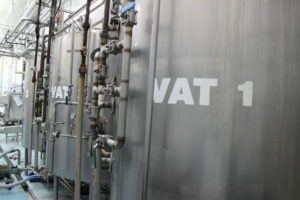USDA Certified Organic
We are proud to offer certified organic products because organic agricultural practices ensure USDA the long-term health of life on our planet, including the soil, plants, animals, and people.
Provision Ingredients organic products carry the USDA Certified Organic seal, which means that they have been grown and processed in accordance with rigorous, national organic standards. The seal also guarantees that an accredited, third party certifying agency has inspected the farms and processing plants to ensure full compliance with these standards.
Non-Homogenized
We do not homogenize Provision Ingredients milk because we believe that milk should be processed as little as possible, and consumed in the most natural state possible. Homogenization, which is not necessary for any food safety reason, destroys the sweet, creamy taste of fresh milk and alters its molecular structure. After non-homogenized milk sits for 12-24 hours, fresh non-homogenized milk separates into a layer of light, high-fat cream (sometimes called the “cream top”) and a much larger, more dense layer of low-fat milk. Over time, the cream becomes thicker, and after a few days it may nearly solidify into a cream “plug.” This is a natural occurrence in non-homogenized milk.
Non- homogenized milk has a naturally sweeter flavor than homogenized milk because whole cream has a silky texture that is lost when the fat globules are broken apart. It also has a richer flavor, even the 2% and fat free, because our skimming process never removes 100% of the cream. Professional and amateur chefs recommend non-homogenized dairy products as ingredients to make the best cheese, yogurt, ice cream, whipped cream, or other dairy-based foods at home or in elegant restaurants.
Grass-Fed
Our farmers know that cows do best when they can harvest their own feed from the pastures around them. Our cows eat a complex diet of native and managed plants and grasses that changes throughout the seasons. Much of the year, the herds harvest their own feed from the farms’ pastures, choosing different feed depending on the weather, the cow’s health, the land on the farm, how close the cow is to giving birth, and the time of year. Pastures may contain just one or two, or up to dozens of species of plants and grasses. Thus, our cows’ diets range from fresh pasture grasses such as indiangrass or switchgrass in early summer, to orchardgrass, ryegrass, or clover in mid-summer. Most surprising cow food choice in fall? Turnips!
During the winter months when the ground is frozen solid in the Midwest, our farmers provide their cows with stored forage, typically grown on the farm or purchased from nearby farms. Depending on the farmer and the situation, winter feed may include one, some, or all of the following organic foods: roasted soybeans (for protein); corn (for energy); barley, hay, haylage, baleage, silage, or wheat.
Pasteurized at Low Temperatures
Different methods of pasteurization affect the taste and quality of milk in different ways. At Provision Ingredients, we use two methods of low temperature pasteurization:
- Batch pasteurization (also called vat pasteurization). All milk was initially pasteurized in this manner. A batch pasteurizer consists of a temperature-controlled, closed vat. The milk is pumped into the vat, heated slowly to a minimum temperature of 145° Fahrenheit, held at that temperature for a minimum of 30 minutes, cooled, and then pumped out of the vat. This method is relatively rare today, and is used mainly by local and regional creameries. The milk in our fluid milk prodcuts, butter, sour cream, and yogurt has been batch pasteurized.
- High Temperature/Short Time (HTST) pasteurization. To pasteurize larger quantities of milk in a more efficient manner, creameries began developing new processes as early as 1893. Today, HTST is the most common form of pasteurization in the milk industry. In an HTST processor, the milk flows continuously through a series of thin metal plates that are heated by hot water. The milk is heated to a minimum of 161° Fahrenheit for at least 15 seconds, and then rapidly cooled. The our cottage cheese and Greek yogurt has been HTST pasteurized.



